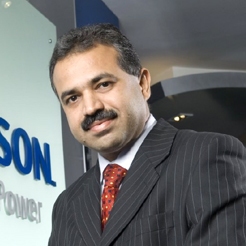Views of Sandeep Nair, MD, Emerson Network Power (India)

A leading player in the passive infrastructure development, monitoring and maintenance space, Emerson Network Power (India)’s Sandeep Nair, Managing Director talks to tele.net.in about the company’s role in the Indian telecom sector, its strategy in this market and future thrust areas. Excerpts…
What has been your role in the country's telecom space?
Since its inception, Emerson has been actively involved in providing cutting edge technology solutions for the telecom players in India. We have been a leader in the passive infrastructure development, monitoring, and maintenance space.
Our products such UPS, precision air conditioners, inverters, DC power system, monitoring solution, racks, shelters and outdoor units and many customised applications have been instrumental in the areas of BTS, MSC, data centers and others. We have a strong legacy of working with all the leading players in the telecom space and they rely on us for our technology and innovation in enabling business critical continuity
What in your opinion is the biggest power-related challenge faced by operators?
A telecom player witnesses the highest per unit cost of downtime amongst all major business sectors in the country. Hence the biggest challenge for any telecom player is to bring this cost down by reducing power downtime. In 2008, Emerson Network Power in association with the Manufacturers Association for Information Technology (MAIT) conducted a countrywide power downtime study which revealed that the telecom sector alone incurred a loss of Rs 6.44 billion annually due to power disruption or downtime. The sector targeted a teledensity in excess of 50 per cent and more than 500 million subscribers.
The telecom industry strives to keep all lines of communication open at all times to serve customers in the best possible way. This becomes crucial especially in the face of natural or manmade calamities. Today wireless and mobile communications are becoming more essential and more complex. Meeting consumer needs requires innovative thinking across the network—from satellite transceivers to cell site multiplexers to Code Division Multiple Access (CDMA) products.
Hence, telecom being a service-driven sector, maintaining business continuity is of utmost importance. Any breakdown can be huge and the impact on lost sales and damaged customer confidence can be disastrous. With such customer centric businesses, the front end and back end have to be effectively integrated to ensure flawless service to the customers.
However, the brighter aspect is that telecom also experiences the fastest restoration, thereby complementing the effectiveness of power management measures.
What are the main challenges facing the company?
It is a demanding proposition to help add value to the burgeoning telecom sector, and all solution providers face this challenge. For Emerson, the focus remains on delivering on the promise of enabling uptime for business critical applications round the year in accordance with the expectations of our customers. The key to our strategy is –
- Understanding customer requirements and delivering products with lowest Total Cost of Ownership in industry
- Understanding current level of technology adaptations and innovations to maintain Emerson’s leadership in the sector
- Understanding and delivering uptime for critical business applications
Going forward, what will be your thrust areas in India?
Telecom is a very important sector for Emerson; in fact it was one of our best performers in 2009 along with IT/ITES, healthcare & government. These sectors also fuelled the growth of data center and cooling solution market in India.
2009 was one of the best years for the Indian telecom industry. This year, India represented the second largest mobile subscriber base in the world with teledensity crossing the 50 per cent mark. More players are debuting this year, and are offering advanced telephony services – a good sign for Indian telecom and for power solution providers.
Has the company looked at green/alternative energy sources? What have been your initiatives in this regard?
The rising cost of power and increased consumption are doing harm to the environment and companies’ profits. These factors have also forced many IT departments to evaluate their data center power consumption and find ways to become more energy-efficient and cost efficient.
To help companies rationalize their power expenditure, Emerson builds power solutions on adaptive architecture – a technology that allows CIOs to adapt to changing power requirements and infrastructure. Power solutions based on this offer –
- Lowest Total Cost of Ownership(TCO)
- Scalable power management
- Flexibility
Emerson has an innovative line-up of energy efficient products that are leaders in their respective industry segments. These products not only ensure clean and efficient power, but also allow for optimization of power management and are thus environment friendly.
Emerson has also pioneered the development of new cooling solutions for high-density servers and switches. The Liebert XD family brings unprecedented flexibility and scalability to data center cooling. These solutions can complement existing cooling systems to increase the utilization of data center space and energy, while enabling a tiered approach to cooling based on temperatures within the entire room, specific zones or individual racks.
- Most Viewed
- Most Rated
- Most Shared
- Related Articles
- R.K. Upadhyay, Chairman and MD, BSNL
- Interview with Shashin Devsare, Executiv...
- Interview with Marten Pieters, MD and CE...
- Marten Pieters, Managing Director and Ch...
- B.S. Shantharaju, CEO, Indus Towers
- Views of Sandeep Nair, MD, Emerson Netwo...
- Interview with Samaresh Parida, Director...
- Interview with Himanshu Kapania, Deputy ...
- Interview with J.S. Sarma, Chairman, TRA...
- Views of Dhananjay Pavgi, Principal Cons...
| Your cart is empty |





